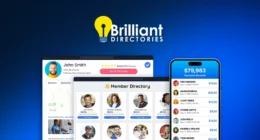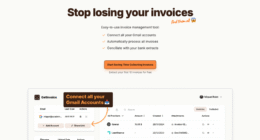Leading ABM platforms like Terminus and Metadata.io consistently earn top ratings (4.5/5 stars) for their extensive feature sets. These solutions excel at account targeting, personalization, and multi-channel engagement capabilities. While basic plans start around $500-1000 monthly, enterprise-level options ($3000+) offer advanced AI-driven insights and predictive analytics. Key considerations include CRM integration potential, automated compliance updates, and robust analytics tracking. Exploring specific platform capabilities reveals which solution best aligns with organizational needs.
Quick Overview
- Terminus leads the ABM software market with 4.5/5 stars, offering excellent native multi-channel campaigns and personalized outreach capabilities.
- Marketo Engage provides AI-driven account scoring and multi-channel personalization, maintaining a strong 4.0 rating from over 2,000 reviews.
- Professional-tier ABM platforms ($1000-3000) offer the best value, balancing advanced features with reasonable pricing for most businesses.
- Top ABM solutions must include account targeting, personalization features, multichannel engagement capabilities, and comprehensive analytics tools.
- Integration flexibility with existing CRM systems and marketing tools is crucial for successful ABM software implementation.
Top-Rated ABM Platforms: A Comprehensive Review

When choosing an Account-Based Marketing (ABM) platform, businesses need reliable data to make informed decisions. User satisfaction ratings and platform capabilities provide valuable insights into the most effective solutions available.
According to G2 ratings, Terminus and Metadata.io lead the pack with 4.5/5 stars, while Marketo maintains a solid 4.0 rating from over 2,000 reviews.
These platforms focus on high-value accounts to maximize return on marketing investments and ensure targeted campaign success.
These platforms excel in different areas:
- Marketo Engage: AI-driven scoring and multi-channel personalization
- Terminus: Native multi-channel campaigns and personalized outreach
- ZoomInfo: Exhaustive data enrichment and precise targeting
- Metadata.io: Automated campaign management with AI optimization
- Demandbase: Real-time engagement tracking and attribution
For businesses seeking advanced features, Personyze offers sophisticated behavioral targeting, while EngageBay provides an affordable solution with a free version for smaller companies.
Essential Features to Look for in ABM Software
Selecting the right Account-Based Marketing (ABM) software requires a thorough understanding of essential features that drive successful campaigns. Five key capabilities stand out as must-haves for effective ABM implementation:
- Account targeting tools that leverage firmographic and intent data to identify and segment high-value prospects
- Personalization features that enable custom content creation and dynamic messaging across channels
- Multichannel engagement capabilities that coordinate outreach across digital ads, email, and social media
- Robust analytics that track engagement scores, ROI, and pipeline influence
- Integration flexibility that guarantees seamless connection with existing CRM and marketing tools
Modern ABM platforms that incorporate these features have helped companies achieve 38% higher win rates compared to traditional marketing approaches. Look for platforms that offer these core functionalities while maintaining scalability to support growing campaign needs and evolving business requirements.
Cost-Benefit Analysis of Leading ABM Solutions

Making a smart investment in ABM software requires careful evaluation of costs versus benefits across different pricing tiers. While free and basic plans offer entry-level features suitable for small businesses, professional and enterprise solutions deliver more sophisticated capabilities for larger organizations.
Key cost-benefit considerations include:
Evaluating ABM software requires balancing feature needs against budget constraints to find the optimal solution for your organization’s scale and goals.
- Free plans ($0) provide basic account targeting and CRM integration but lack advanced features and support.
- Basic plans ($500-1000) offer essential tools for small businesses while maintaining cost-effectiveness.
- Professional plans ($1000-3000) balance advanced features with reasonable pricing for mid-sized companies.
- Enterprise solutions ($3000+) justify higher costs through AI-driven insights and extensive support.
Industry leaders like 6sense and Demandbase demonstrate strong ROI for larger organizations, though their pricing may be prohibitive for smaller teams exploring ABM strategies. For businesses prioritizing affordability while maintaining essential functionality, EngageBay’s free version includes email templates and landing page A/B testing capabilities.
Implementation and Integration Best Practices
After evaluating the costs and benefits of various ABM solutions, organizations must turn their attention to effective implementation and integration practices. Success hinges on three core elements: unified data management, cross-team collaboration, and seamless technology integration.
Organizations should start by consolidating data from all departments into a single source of truth, ensuring consistent messaging across campaigns. Regular data hygiene practices, including standardization and de-duplication, are essential for maintaining accuracy. Complex account intelligence frameworks are critical for effectively mapping and monitoring enterprise relationships. Teams must establish clear communication channels and shared KPIs to avoid silos, while implementing role-based workflows streamlines campaign execution.
For superior results, companies should:
- Prioritize ABM tools that integrate with existing CRM systems
- Conduct thorough tech stack audits
- Implement in-depth training programs
- Use collaborative tools to track campaign progress
- Leverage APIs for smooth data flow
Future-Proofing Your ABM Software Investment

Three critical elements drive the future-proofing of ABM software investments: data analytics capabilities, scalable infrastructure, and adaptable technology. Successful ABM platforms must evolve alongside market demands while maintaining operational efficiency and ROI-focused outcomes.
With decision-makers completing 70% of the buyer’s journey before engaging sales teams, ABM software must excel at early-stage engagement and tracking.
Companies should prioritize these future-ready features when selecting ABM software:
- AI-powered predictive analytics that continuously learn from customer interactions and market trends
- Multi-channel engagement capabilities that adapt to emerging communication platforms
- Automated compliance updates that respond to changing privacy regulations
- Seamless integration potential with new marketing technologies and data sources
The implementation of forward-thinking ABM solutions enables organizations to maintain competitive advantages through dynamic market changes. By focusing on platforms with robust innovation roadmaps, businesses can guarantee their ABM investments deliver long-term value while supporting evolving customer engagement strategies.
Frequently Asked Questions
How Long Does It Typically Take to See ROI From ABM Software?
Most companies see ROI from ABM software within 6-12 months, though timelines vary based on several factors.
Simple B2B offerings can generate returns in 3-6 months, while complex enterprise deals may take 12-18 months or longer.
Key factors affecting ROI timing include sales cycle length, campaign complexity, and industry type. Technology sectors often experience longer timelines due to higher deal values and multiple decision-makers involved in the purchasing process.
Can Small Businesses Benefit From Implementing ABM Software?
ABM software can notably benefit small businesses. Research shows that over 75% of businesses achieve at least a 10% increase in ROI after implementation.
Small companies can leverage ABM to target high-value accounts effectively, reduce marketing waste, and create personalized campaigns. The software’s data-driven approach helps align sales and marketing teams, while its targeted strategy improves customer relationships through better engagement and understanding of specific client needs.
What Team Size Is Recommended to Manage ABM Software Effectively?
The recommended team size for managing ABM software varies based on the scale of the business. Small businesses can effectively operate with 2-3 team members covering essential functions. Mid-sized companies typically need 5-10 members to handle specialized roles, while enterprise organizations require 10+ team members.
The general rule is having one marketer support up to 10 salespeople, with each salesperson managing up to 10 target accounts. Core roles should include content creation, analytics, and sales enablement.
How Often Should ABM Software Campaigns Be Updated or Reviewed?
ABM campaigns require consistent monitoring and updates to maintain effectiveness. Monthly reviews should focus on performance metrics and engagement rates, while quarterly deep-dives examine overall strategy and ROI.
Immediate updates are necessary when creative content shows fatigue or performance drops. Data cleansing should occur at least annually, as contact information typically degrades by 20% each year.
Teams should also conduct weekly check-ins to address any emerging issues or opportunities.
Is Industry-Specific Experience Important When Choosing an ABM Software Provider?
Industry-specific experience is highly valuable when selecting an ABM software provider. Vendors with deep industry knowledge typically offer more targeted features, better personalization capabilities, and understand sector-specific challenges.
This expertise translates into more effective campaigns, higher ROI, and improved operational efficiency. Research shows companies using industry-aligned ABM tools often exceed revenue targets by 6% and achieve better customer retention rates of up to 36%.
Conclusion
Selecting the right ABM software is like finding a needle in a haystack the size of Mount Everest – seemingly impossible yet critically important. By carefully evaluating features, costs, and integration capabilities, businesses can identify platforms that align with their goals and scalability needs. A thoughtful investment in ABM technology today, coupled with proper implementation and future-proofing strategies, positions organizations for sustained success in targeted marketing efforts.








